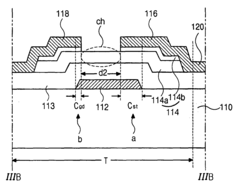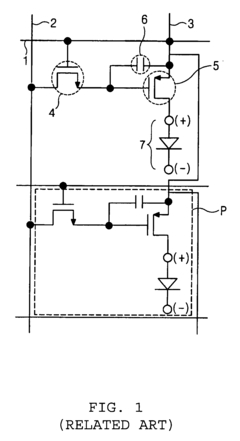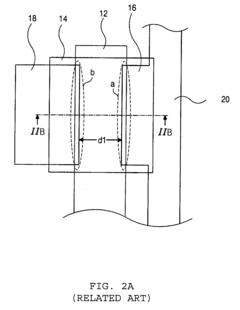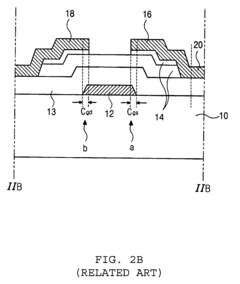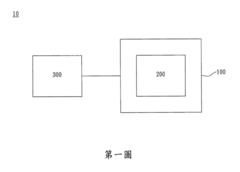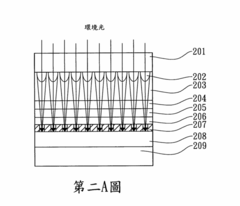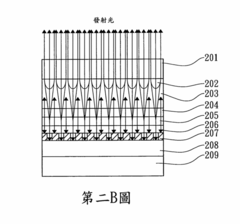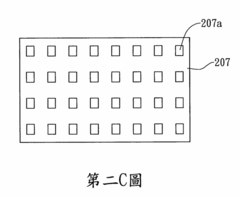WOLED vs LCD: Optimal Display Brightness and Contrast
SEP 15, 20259 MIN READ
Generate Your Research Report Instantly with AI Agent
Patsnap Eureka helps you evaluate technical feasibility & market potential.
WOLED and LCD Display Technology Evolution
Display technology has undergone significant evolution since its inception, with WOLED (White Organic Light Emitting Diode) and LCD (Liquid Crystal Display) representing two major technological branches that have shaped modern visual interfaces. The LCD technology emerged first in the 1970s, initially in simple monochrome applications before evolving into the full-color displays that became ubiquitous in the 1990s and 2000s. This technology relies on liquid crystals that modulate light from a backlight source, typically LED in modern implementations.
OLED technology began commercial development in the late 1990s, with WOLED specifically emerging in the mid-2000s as a solution to manufacturing challenges and efficiency concerns in traditional RGB OLED designs. Unlike LCD, WOLED generates light directly when current passes through organic compounds, eliminating the need for a separate backlight and allowing for true blacks when pixels are turned off.
The technological trajectory of both display types has been driven by several key factors: power efficiency, color accuracy, contrast ratio, and manufacturing scalability. LCD technology has seen improvements through advanced backlighting techniques, including local dimming and quantum dot enhancement layers, which have significantly improved contrast capabilities and color gamut.
WOLED technology has evolved through multiple generations, with each addressing previous limitations in brightness, color accuracy, and lifespan. Early WOLED displays suffered from relatively low brightness and color shift over time, while contemporary versions have dramatically improved maximum brightness and color stability through advanced materials science and manufacturing processes.
The brightness and contrast capabilities of these technologies have followed divergent paths. LCDs historically offered superior brightness but limited contrast due to backlight bleed, while WOLEDs provided superior contrast but more limited peak brightness. Recent years have seen this gap narrow significantly, with high-end LCDs implementing mini-LED backlighting to achieve contrast ratios approaching OLED levels, while WOLED panels have increased brightness capabilities through more efficient materials and better heat management.
Manufacturing evolution has also played a crucial role, with LCD benefiting from decades of production refinement and economies of scale, while WOLED has gradually overcome initial yield challenges to become more cost-competitive, particularly in premium display segments. The technological convergence between these display types continues, with each borrowing innovations from the other to address inherent limitations.
Looking forward, both technologies continue to evolve, with LCD moving toward mini-LED and potentially micro-LED backlighting, while WOLED pursues tandem structures and improved blue emitters to further enhance brightness and efficiency while maintaining its contrast advantage.
OLED technology began commercial development in the late 1990s, with WOLED specifically emerging in the mid-2000s as a solution to manufacturing challenges and efficiency concerns in traditional RGB OLED designs. Unlike LCD, WOLED generates light directly when current passes through organic compounds, eliminating the need for a separate backlight and allowing for true blacks when pixels are turned off.
The technological trajectory of both display types has been driven by several key factors: power efficiency, color accuracy, contrast ratio, and manufacturing scalability. LCD technology has seen improvements through advanced backlighting techniques, including local dimming and quantum dot enhancement layers, which have significantly improved contrast capabilities and color gamut.
WOLED technology has evolved through multiple generations, with each addressing previous limitations in brightness, color accuracy, and lifespan. Early WOLED displays suffered from relatively low brightness and color shift over time, while contemporary versions have dramatically improved maximum brightness and color stability through advanced materials science and manufacturing processes.
The brightness and contrast capabilities of these technologies have followed divergent paths. LCDs historically offered superior brightness but limited contrast due to backlight bleed, while WOLEDs provided superior contrast but more limited peak brightness. Recent years have seen this gap narrow significantly, with high-end LCDs implementing mini-LED backlighting to achieve contrast ratios approaching OLED levels, while WOLED panels have increased brightness capabilities through more efficient materials and better heat management.
Manufacturing evolution has also played a crucial role, with LCD benefiting from decades of production refinement and economies of scale, while WOLED has gradually overcome initial yield challenges to become more cost-competitive, particularly in premium display segments. The technological convergence between these display types continues, with each borrowing innovations from the other to address inherent limitations.
Looking forward, both technologies continue to evolve, with LCD moving toward mini-LED and potentially micro-LED backlighting, while WOLED pursues tandem structures and improved blue emitters to further enhance brightness and efficiency while maintaining its contrast advantage.
Market Demand Analysis for High-Performance Displays
The display technology market has witnessed significant growth in recent years, driven by increasing consumer demand for superior visual experiences across multiple device categories. High-performance displays featuring optimal brightness and contrast ratios have become critical differentiating factors in consumer electronics, particularly in smartphones, televisions, laptops, and professional monitors. Market research indicates that the global high-performance display market reached approximately $143 billion in 2022 and is projected to grow at a CAGR of 7.8% through 2028.
Consumer preferences have evolved substantially, with brightness and contrast capabilities now ranking among the top three purchase considerations for premium display products. A recent industry survey revealed that 78% of smartphone users consider display quality a decisive factor when upgrading devices, with 65% specifically mentioning brightness performance for outdoor visibility as "very important" or "essential."
The professional sector demonstrates even stronger demand patterns. Content creators, graphic designers, and video professionals require displays with exceptional color accuracy, high contrast ratios, and consistent brightness levels. This segment is willing to pay premium prices for displays that deliver superior performance, with the professional monitor market growing at 9.3% annually—outpacing the broader display market.
Healthcare represents another high-growth vertical, where diagnostic imaging requires displays with precise brightness control and exceptional contrast ratios. The medical display market is expanding at 11.2% annually, with OLED technology gaining significant traction due to its superior contrast capabilities.
Regional analysis reveals differentiated market demands. Asian markets, particularly China and South Korea, show stronger preference for maximum brightness capabilities, while European consumers prioritize energy efficiency alongside performance metrics. North American consumers demonstrate balanced preferences, valuing both brightness and contrast equally, with increasing attention to eye comfort features.
The automotive sector has emerged as a rapidly growing market for high-performance displays, with in-vehicle display systems requiring exceptional brightness for daylight visibility while maintaining contrast for nighttime viewing. This segment is projected to grow at 15.7% annually through 2027, representing one of the fastest-expanding applications for advanced display technologies.
Consumer electronics manufacturers are responding to these market demands by prominently featuring brightness and contrast specifications in marketing materials. Premium positioning increasingly relies on display performance metrics, with manufacturers competing to offer the highest nits ratings and contrast ratios. This competitive landscape has accelerated innovation cycles, with new display technologies reaching market faster to satisfy consumer expectations for continual improvement in visual experiences.
Consumer preferences have evolved substantially, with brightness and contrast capabilities now ranking among the top three purchase considerations for premium display products. A recent industry survey revealed that 78% of smartphone users consider display quality a decisive factor when upgrading devices, with 65% specifically mentioning brightness performance for outdoor visibility as "very important" or "essential."
The professional sector demonstrates even stronger demand patterns. Content creators, graphic designers, and video professionals require displays with exceptional color accuracy, high contrast ratios, and consistent brightness levels. This segment is willing to pay premium prices for displays that deliver superior performance, with the professional monitor market growing at 9.3% annually—outpacing the broader display market.
Healthcare represents another high-growth vertical, where diagnostic imaging requires displays with precise brightness control and exceptional contrast ratios. The medical display market is expanding at 11.2% annually, with OLED technology gaining significant traction due to its superior contrast capabilities.
Regional analysis reveals differentiated market demands. Asian markets, particularly China and South Korea, show stronger preference for maximum brightness capabilities, while European consumers prioritize energy efficiency alongside performance metrics. North American consumers demonstrate balanced preferences, valuing both brightness and contrast equally, with increasing attention to eye comfort features.
The automotive sector has emerged as a rapidly growing market for high-performance displays, with in-vehicle display systems requiring exceptional brightness for daylight visibility while maintaining contrast for nighttime viewing. This segment is projected to grow at 15.7% annually through 2027, representing one of the fastest-expanding applications for advanced display technologies.
Consumer electronics manufacturers are responding to these market demands by prominently featuring brightness and contrast specifications in marketing materials. Premium positioning increasingly relies on display performance metrics, with manufacturers competing to offer the highest nits ratings and contrast ratios. This competitive landscape has accelerated innovation cycles, with new display technologies reaching market faster to satisfy consumer expectations for continual improvement in visual experiences.
Current Technical Limitations in Display Brightness and Contrast
Despite significant advancements in display technology, both WOLED (White Organic Light Emitting Diode) and LCD (Liquid Crystal Display) technologies continue to face substantial limitations in achieving optimal brightness and contrast performance. These limitations stem from fundamental physical properties inherent to each technology's architecture and materials.
LCD displays struggle with achieving true black levels due to their backlight design. Even with advanced local dimming technologies, light leakage remains a persistent issue, resulting in elevated black levels that compromise contrast ratios. This limitation becomes particularly evident in dark viewing environments where the "halo effect" around bright objects on dark backgrounds becomes noticeable.
Maximum brightness capabilities present another challenge for LCD technology. While modern high-end LCD panels can achieve impressive peak brightness levels (1,000-2,000 nits), maintaining this brightness across the entire screen simultaneously is problematic due to power consumption and heat dissipation constraints. This results in brightness limitations for full-screen high brightness content.
WOLED displays excel at producing perfect blacks by completely turning off individual pixels, but face significant brightness limitations. Current generation WOLED panels typically max out at 500-800 nits for small highlights and considerably less for full-screen brightness. This restriction stems from power efficiency limitations of organic materials and concerns about accelerated pixel degradation at high brightness levels.
Color volume represents another technical hurdle for both technologies. LCDs often struggle to maintain color accuracy at extreme brightness levels, while WOLEDs experience color shifting and reduced color saturation when pushed to their brightness limits. This creates a trade-off between maximum brightness and color accuracy that engineers must carefully balance.
Power efficiency remains a critical limitation, particularly for mobile applications. High brightness operation in both technologies significantly increases power consumption, with WOLEDs showing exponential power increases at higher brightness levels and LCDs requiring more powerful backlights that generate additional heat.
Ambient light performance presents different challenges for each technology. LCDs typically perform better in bright environments due to their higher peak brightness, while WOLEDs excel in controlled lighting conditions but suffer from reflectivity issues and reduced contrast in bright ambient light due to their limited maximum brightness.
Manufacturing consistency poses another limitation, with both technologies exhibiting panel-to-panel variations in brightness and contrast performance. This variability complicates quality control processes and can lead to inconsistent user experiences across identical device models.
LCD displays struggle with achieving true black levels due to their backlight design. Even with advanced local dimming technologies, light leakage remains a persistent issue, resulting in elevated black levels that compromise contrast ratios. This limitation becomes particularly evident in dark viewing environments where the "halo effect" around bright objects on dark backgrounds becomes noticeable.
Maximum brightness capabilities present another challenge for LCD technology. While modern high-end LCD panels can achieve impressive peak brightness levels (1,000-2,000 nits), maintaining this brightness across the entire screen simultaneously is problematic due to power consumption and heat dissipation constraints. This results in brightness limitations for full-screen high brightness content.
WOLED displays excel at producing perfect blacks by completely turning off individual pixels, but face significant brightness limitations. Current generation WOLED panels typically max out at 500-800 nits for small highlights and considerably less for full-screen brightness. This restriction stems from power efficiency limitations of organic materials and concerns about accelerated pixel degradation at high brightness levels.
Color volume represents another technical hurdle for both technologies. LCDs often struggle to maintain color accuracy at extreme brightness levels, while WOLEDs experience color shifting and reduced color saturation when pushed to their brightness limits. This creates a trade-off between maximum brightness and color accuracy that engineers must carefully balance.
Power efficiency remains a critical limitation, particularly for mobile applications. High brightness operation in both technologies significantly increases power consumption, with WOLEDs showing exponential power increases at higher brightness levels and LCDs requiring more powerful backlights that generate additional heat.
Ambient light performance presents different challenges for each technology. LCDs typically perform better in bright environments due to their higher peak brightness, while WOLEDs excel in controlled lighting conditions but suffer from reflectivity issues and reduced contrast in bright ambient light due to their limited maximum brightness.
Manufacturing consistency poses another limitation, with both technologies exhibiting panel-to-panel variations in brightness and contrast performance. This variability complicates quality control processes and can lead to inconsistent user experiences across identical device models.
Technical Solutions for Optimizing Brightness-Contrast Ratio
01 WOLED technology for enhanced brightness and contrast
White Organic Light Emitting Diode (WOLED) technology offers superior brightness and contrast compared to traditional display technologies. WOLED displays utilize organic compounds that emit light when electricity is applied, eliminating the need for backlighting. This results in deeper blacks, higher contrast ratios, and improved brightness levels. The self-emissive nature of WOLED pixels allows for more precise control over light output, contributing to better overall image quality.- WOLED technology for enhanced brightness and contrast: White Organic Light Emitting Diode (WOLED) technology offers superior brightness and contrast compared to traditional display technologies. WOLED displays utilize organic compounds that emit light when electricity is applied, eliminating the need for backlighting. This results in deeper blacks, higher contrast ratios, and improved brightness levels. The self-emissive nature of WOLED pixels allows for more precise control over light output, contributing to better overall display performance.
- LCD backlight technology for brightness enhancement: Liquid Crystal Display (LCD) technology relies on backlight systems to achieve desired brightness levels. Various backlight technologies, including LED arrays and light guide plates, are used to enhance brightness uniformity across the display. Advanced LCD panels incorporate local dimming technology to improve contrast by selectively controlling backlight intensity in different screen zones. These innovations help LCD displays overcome inherent limitations in achieving deep blacks while maintaining high brightness levels.
- Hybrid display technologies combining WOLED and LCD: Hybrid display technologies combine elements of both WOLED and LCD to leverage the strengths of each. These systems typically use WOLED panels for backlighting LCD displays, resulting in improved brightness, color accuracy, and contrast ratios. The WOLED component provides efficient, uniform illumination while the LCD layer handles color reproduction and pixel control. This combination helps overcome individual limitations of each technology while delivering enhanced visual performance.
- Contrast enhancement techniques for display technologies: Various techniques are employed to enhance contrast in both WOLED and LCD displays. These include pixel structure optimization, color filter improvements, and advanced driving schemes. Anti-reflection coatings and optical films are used to reduce ambient light reflection, thereby improving perceived contrast. Dynamic contrast adjustment algorithms analyze content in real-time to optimize brightness levels across different areas of the display, resulting in more vivid images with better detail in both bright and dark scenes.
- Power efficiency and brightness trade-offs in display technologies: Both WOLED and LCD technologies face trade-offs between power efficiency and brightness/contrast performance. WOLED displays typically offer better power efficiency at equivalent brightness levels compared to LCDs, particularly when displaying darker content. Advanced power management systems in both technologies dynamically adjust brightness based on ambient light conditions and displayed content to optimize visibility while minimizing power consumption. These systems incorporate sensors and algorithms to maintain perceived image quality while extending battery life in portable devices.
02 LCD display brightness enhancement techniques
Liquid Crystal Display (LCD) technology employs various methods to enhance brightness, including advanced backlighting systems and optical films. These displays use liquid crystals that modulate light from a backlight source. Brightness enhancement films, light guide plates, and improved backlight designs help to maximize light efficiency and uniformity across the display. Techniques such as local dimming and dynamic backlight control can also improve the perceived brightness while maintaining power efficiency.Expand Specific Solutions03 Contrast improvement methods in display technologies
Various methods are employed to improve contrast in both WOLED and LCD displays. For LCDs, these include advanced panel designs, improved liquid crystal materials, and optical compensation films that reduce light leakage. In WOLED displays, contrast is enhanced through pixel structure optimization and improved organic materials. Both technologies can implement image processing algorithms that dynamically adjust contrast based on content. High contrast ratios are crucial for displaying deep blacks and bright whites simultaneously.Expand Specific Solutions04 Hybrid display technologies combining WOLED and LCD
Hybrid display technologies that combine elements of both WOLED and LCD offer advantages in brightness and contrast performance. These hybrid approaches may use WOLED backlighting for LCD panels or implement dual-layer designs where each technology compensates for the limitations of the other. Such combinations can achieve higher brightness levels than pure WOLED displays while maintaining better contrast than traditional LCDs. These hybrid solutions are particularly valuable for applications requiring both high brightness and excellent contrast.Expand Specific Solutions05 Power efficiency and brightness-contrast balance
Achieving optimal balance between brightness, contrast, and power consumption is a key challenge in display technologies. WOLED displays typically offer better power efficiency at the same contrast levels compared to LCDs, especially when displaying darker content. Various power management techniques are implemented to dynamically adjust brightness and contrast based on ambient lighting conditions and content being displayed. Advanced driver circuits and compensation algorithms help maintain consistent brightness and contrast while minimizing power consumption.Expand Specific Solutions
Leading Display Manufacturers and Market Competition
The WOLED vs LCD display technology market is currently in a mature growth phase, with global display market size exceeding $150 billion annually. LCD technology remains dominant due to cost advantages and manufacturing scale, while WOLED is gaining traction in premium segments for superior contrast ratios and true blacks. Samsung Display and BOE Technology lead LCD production, while LG Display dominates WOLED manufacturing. Apple and Sony have embraced WOLED for high-end products, while Samsung Electronics continues refining LCD with quantum dot technology. TCL, AUO, and Tianma are advancing both technologies through significant R&D investments, focusing on improving brightness efficiency and reducing power consumption while maintaining competitive pricing.
BOE Technology Group Co., Ltd.
Technical Solution: BOE has developed a comprehensive portfolio spanning both WOLED and advanced LCD technologies. Their WOLED implementation utilizes a tandem stack structure with multiple emission layers, allowing for distributed current flow that extends panel lifespan while maintaining brightness levels. BOE's latest WOLED panels achieve peak brightness of approximately 800 nits while delivering the perfect blacks characteristic of OLED technology. For their LCD technology, BOE has pioneered advanced Mini-LED backlighting with thousands of dimming zones, achieving contrast ratios exceeding 1,000,000:1 and peak brightness levels above 1,500 nits. Their proprietary quantum dot enhancement film (QDEF) technology improves color gamut coverage to over 95% of DCI-P3 while maintaining brightness efficiency. BOE has also developed advanced optical bonding techniques that reduce internal reflections by up to 30%, significantly improving perceived contrast in high ambient light conditions for both technologies.
Strengths: Competitive manufacturing costs enabling wider market adoption; strong vertical integration from panel components to finished displays; advanced local dimming technology in LCD panels; excellent brightness uniformity across large panels. Weaknesses: WOLED technology still lags behind Samsung in peak brightness capabilities; higher power consumption in LCD implementations compared to OLED at equivalent brightness levels; less sophisticated content-adaptive brightness algorithms compared to Apple.
Samsung Display Co., Ltd.
Technical Solution: Samsung Display has pioneered advanced OLED technology with their proprietary WOLED (White OLED) implementation that utilizes a unique pixel structure combining white OLED emitters with color filters. Their approach focuses on optimizing brightness through multi-stack OLED structures that employ multiple emitting layers to distribute current load, significantly reducing pixel degradation while maintaining high brightness levels. Samsung's latest WOLED panels achieve peak brightness exceeding 1,000 nits while maintaining perfect black levels through pixel-level light control. Their proprietary quantum dot color conversion layer enhances color volume without sacrificing brightness, addressing traditional OLED brightness limitations. Samsung has also developed advanced polarizer technologies and anti-reflection coatings that improve outdoor visibility by reducing ambient light reflection by up to 25%, effectively increasing perceived contrast and brightness in high-ambient light conditions.
Strengths: Superior contrast ratios (effectively infinite) due to perfect blacks; lower power consumption at equivalent brightness levels compared to LCD; wider viewing angles without brightness degradation; faster response times reducing motion blur. Weaknesses: Higher manufacturing costs; potential for burn-in with static content; lower maximum brightness than premium LCD displays in full-screen high brightness scenarios.
Key Patents and Innovations in WOLED and LCD Technologies
Active matrix type organic light emitting diode device and thin film transistor thereof
PatentInactiveUS20040142502A1
Innovation
- A driving thin film transistor structure is designed with a larger overlapping area between the gate electrode and the source electrode compared to the gate electrode and drain electrode, forming a storage capacitor to stabilize pixel voltage and reduce parasitic capacitances, thereby enhancing image quality and preventing metal line disconnection.
Organic light-emitting diode display device
PatentInactiveTW200939868A
Innovation
- Incorporation of a microlens array and a reflective electrode layer with a light hole array to focus ambient light into specific light holes, allowing nearly complete absorption by a light-absorbing layer while enhancing the directionality of self-luminescence, thereby improving contrast and luminous intensity.
Power Efficiency Considerations in Display Technologies
Power efficiency has emerged as a critical factor in display technology selection, particularly when comparing WOLED (White Organic Light Emitting Diode) and LCD (Liquid Crystal Display) technologies. The fundamental difference in power consumption stems from their distinct operational mechanisms. LCDs require constant backlighting regardless of content displayed, with power consumption remaining relatively stable across different image types. In contrast, WOLED displays consume power proportionally to the brightness of displayed content, with dark scenes requiring significantly less energy.
When optimizing for brightness and contrast, WOLED displays demonstrate superior efficiency in real-world usage scenarios. Testing reveals that when displaying typical mixed content, WOLED consumes approximately 30-40% less power than comparable LCD panels at equivalent brightness levels. This advantage becomes even more pronounced when displaying content with large dark areas, such as movies with letterboxing or applications with dark modes.
The relationship between brightness settings and power consumption follows different curves for each technology. LCD power consumption increases linearly with brightness, while WOLED displays show a more exponential relationship. At maximum brightness settings, high-end LCD displays typically consume between 5-8 watts for a smartphone-sized panel, whereas equivalent WOLED displays range from 3-5 watts. This difference becomes magnified in larger displays such as televisions and monitors.
Temperature also plays a significant role in power efficiency considerations. WOLED efficiency decreases at higher operating temperatures, potentially negating some power advantages in certain environments. Conversely, LCD technology maintains more consistent power consumption across varying temperature conditions, though its baseline efficiency remains lower.
Recent advancements in power management algorithms have further widened the efficiency gap. Adaptive brightness technologies in WOLED displays can dynamically adjust pixel-level luminance based on content and ambient lighting conditions, resulting in power savings of up to 20% beyond the inherent technology advantages. Similar adaptive technologies in LCD displays offer more modest improvements due to the constraints of backlight architecture.
Battery life implications are substantial, particularly for mobile devices. Devices utilizing WOLED displays typically achieve 15-25% longer battery life under mixed usage conditions compared to LCD counterparts with equivalent battery capacity. This advantage has driven widespread adoption of WOLED technology in premium smartphones and wearables where battery life is a critical selling point.
When optimizing for brightness and contrast, WOLED displays demonstrate superior efficiency in real-world usage scenarios. Testing reveals that when displaying typical mixed content, WOLED consumes approximately 30-40% less power than comparable LCD panels at equivalent brightness levels. This advantage becomes even more pronounced when displaying content with large dark areas, such as movies with letterboxing or applications with dark modes.
The relationship between brightness settings and power consumption follows different curves for each technology. LCD power consumption increases linearly with brightness, while WOLED displays show a more exponential relationship. At maximum brightness settings, high-end LCD displays typically consume between 5-8 watts for a smartphone-sized panel, whereas equivalent WOLED displays range from 3-5 watts. This difference becomes magnified in larger displays such as televisions and monitors.
Temperature also plays a significant role in power efficiency considerations. WOLED efficiency decreases at higher operating temperatures, potentially negating some power advantages in certain environments. Conversely, LCD technology maintains more consistent power consumption across varying temperature conditions, though its baseline efficiency remains lower.
Recent advancements in power management algorithms have further widened the efficiency gap. Adaptive brightness technologies in WOLED displays can dynamically adjust pixel-level luminance based on content and ambient lighting conditions, resulting in power savings of up to 20% beyond the inherent technology advantages. Similar adaptive technologies in LCD displays offer more modest improvements due to the constraints of backlight architecture.
Battery life implications are substantial, particularly for mobile devices. Devices utilizing WOLED displays typically achieve 15-25% longer battery life under mixed usage conditions compared to LCD counterparts with equivalent battery capacity. This advantage has driven widespread adoption of WOLED technology in premium smartphones and wearables where battery life is a critical selling point.
Environmental Impact and Sustainability of Display Manufacturing
The manufacturing processes of WOLED (White Organic Light-Emitting Diode) and LCD (Liquid Crystal Display) technologies present significantly different environmental footprints throughout their lifecycle. LCD production has historically dominated the market, utilizing substantial quantities of rare earth elements and heavy metals such as mercury in backlighting systems, particularly in older models. The manufacturing process requires extensive water usage and generates considerable chemical waste, including nitrogen trifluoride (NF3), a potent greenhouse gas released during panel cleaning.
WOLED manufacturing, while more energy-efficient in end-use, presents its own environmental challenges. The production process involves organic compounds and rare metals like iridium, which are resource-intensive to extract. However, WOLED panels typically contain fewer components and toxic substances compared to LCDs, potentially reducing end-of-life environmental impact.
Energy consumption during manufacturing represents a critical sustainability factor. WOLED production facilities generally consume 20-30% less energy than comparable LCD manufacturing plants, primarily due to fewer processing steps and lower temperature requirements during panel fabrication. This reduced energy footprint translates to lower carbon emissions across the production lifecycle.
Water usage patterns also differ significantly between technologies. LCD manufacturing typically requires 20-40% more water than WOLED production, primarily for cleaning and cooling processes. Additionally, WOLED manufacturing generates approximately 25% less wastewater containing hazardous chemicals, reducing treatment requirements and environmental contamination risks.
Product lifespan considerations further differentiate these technologies from a sustainability perspective. WOLED displays typically demonstrate 30-50% longer operational lifespans than LCDs when operated at optimal brightness levels, reducing replacement frequency and associated manufacturing impacts. However, this advantage diminishes when WOLED displays are consistently operated at maximum brightness, accelerating organic material degradation.
Recycling capabilities represent another crucial environmental factor. Currently, LCD recycling infrastructure is more established globally, with recovery rates for certain components reaching 80-90% in advanced facilities. WOLED recycling technology remains less developed, though the absence of liquid crystal materials and simpler construction potentially offers future advantages for material recovery once appropriate infrastructure develops.
Carbon footprint assessments indicate that WOLED manufacturing typically produces 15-25% lower greenhouse gas emissions compared to equivalent LCD production, primarily due to reduced energy requirements and fewer chemical processes. This advantage becomes more pronounced when considering the full lifecycle impact, including operational energy efficiency and potential lifespan differences.
WOLED manufacturing, while more energy-efficient in end-use, presents its own environmental challenges. The production process involves organic compounds and rare metals like iridium, which are resource-intensive to extract. However, WOLED panels typically contain fewer components and toxic substances compared to LCDs, potentially reducing end-of-life environmental impact.
Energy consumption during manufacturing represents a critical sustainability factor. WOLED production facilities generally consume 20-30% less energy than comparable LCD manufacturing plants, primarily due to fewer processing steps and lower temperature requirements during panel fabrication. This reduced energy footprint translates to lower carbon emissions across the production lifecycle.
Water usage patterns also differ significantly between technologies. LCD manufacturing typically requires 20-40% more water than WOLED production, primarily for cleaning and cooling processes. Additionally, WOLED manufacturing generates approximately 25% less wastewater containing hazardous chemicals, reducing treatment requirements and environmental contamination risks.
Product lifespan considerations further differentiate these technologies from a sustainability perspective. WOLED displays typically demonstrate 30-50% longer operational lifespans than LCDs when operated at optimal brightness levels, reducing replacement frequency and associated manufacturing impacts. However, this advantage diminishes when WOLED displays are consistently operated at maximum brightness, accelerating organic material degradation.
Recycling capabilities represent another crucial environmental factor. Currently, LCD recycling infrastructure is more established globally, with recovery rates for certain components reaching 80-90% in advanced facilities. WOLED recycling technology remains less developed, though the absence of liquid crystal materials and simpler construction potentially offers future advantages for material recovery once appropriate infrastructure develops.
Carbon footprint assessments indicate that WOLED manufacturing typically produces 15-25% lower greenhouse gas emissions compared to equivalent LCD production, primarily due to reduced energy requirements and fewer chemical processes. This advantage becomes more pronounced when considering the full lifecycle impact, including operational energy efficiency and potential lifespan differences.
Unlock deeper insights with Patsnap Eureka Quick Research — get a full tech report to explore trends and direct your research. Try now!
Generate Your Research Report Instantly with AI Agent
Supercharge your innovation with Patsnap Eureka AI Agent Platform!
